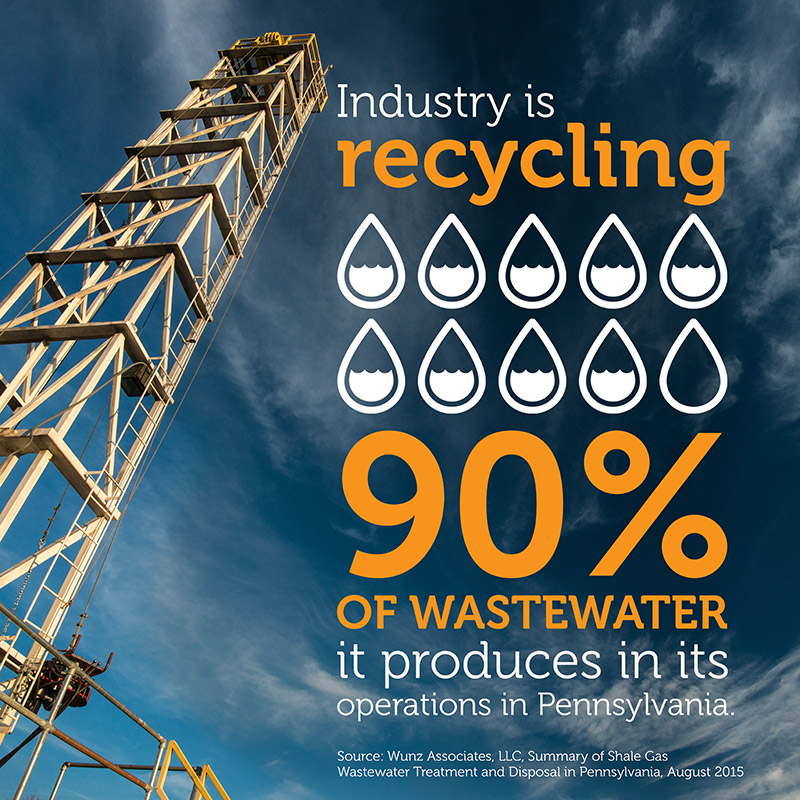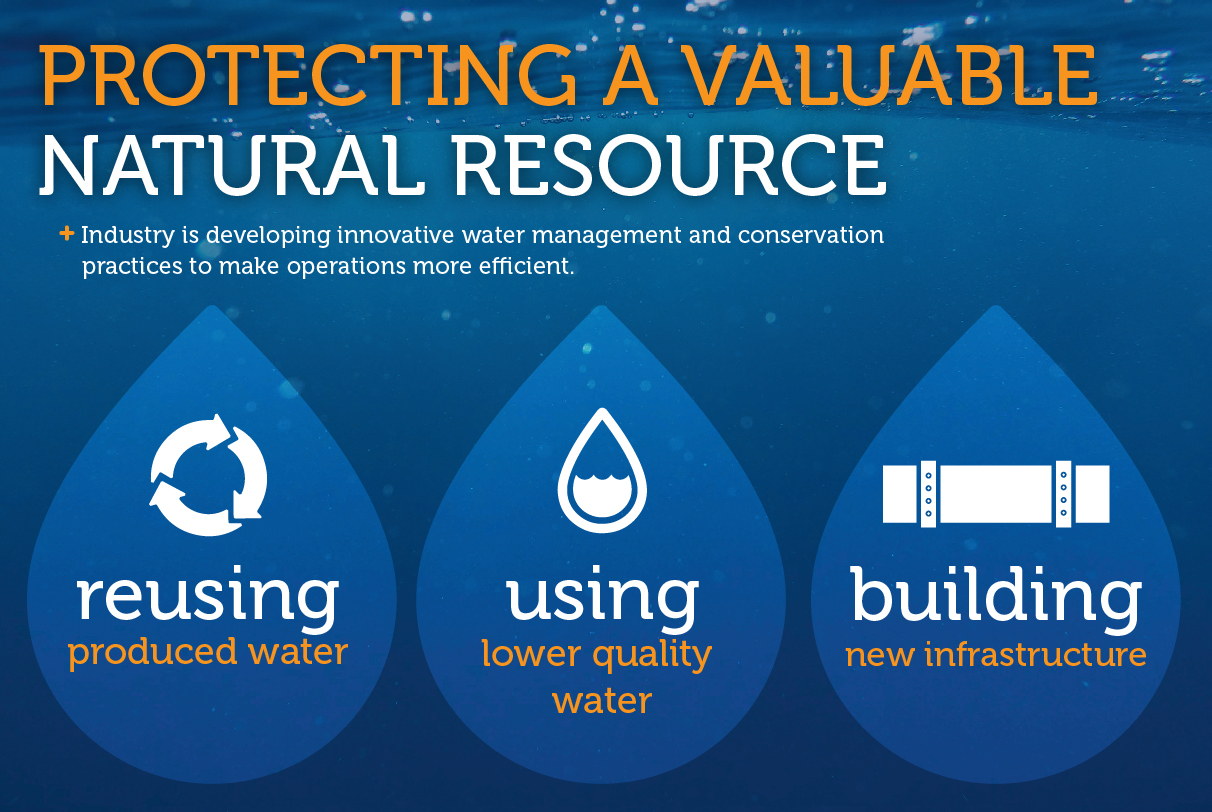Vote For Water Management And Conservation - Vote4Energy
Kate Lowery
Posted September 1, 2016
Our industry understands that water is a valuable natural resource. That’s why oil and natural gas companies are constantly improving their water management and conservation practices. Company efforts typically fall into three different categories.
First, where possible, companies examine alternatives to using fresh water. Water plays an important role throughout many oil and natural gas activities, including hydraulic fracturing, processing and refining. However, innovations in water treatment mean that companies can now effectively use many different types of water in their activities. Common sources include surface water, groundwater and municipal water of varying qualities.
Second, companies are diligent about capturing water produced during the exploration and production process. New water technologies and sophisticated fracturing chemistries help companies make use of this water more frequently as well. For example, our industry recently reached a milestone of recycling more than 90 percent of the wastewater produced from exploration and production activities in Pennsylvania.
Finally, companies are building new water infrastructure systems to transport water more efficiently.
Corporate activities can vary widely depending on factors that include local water stresses, individual business needs and even the particular requirements of specific geologic formations. The case studies featured here are just a few examples of some of the many innovative water management techniques that companies are using.
Using Lower Quality Water from Nontraditional Sources
Companies reduce their fresh water needs by using recycled and reclaimed water from a variety of sources, including local wastewater treatment plants.
In California, Chevron’s refineries use recycled and reclaimed water to meet much of their water needs. Since 1999, Chevron has used recycled water for more than 70 percent of water needs at its El Segundo Refinery and today, reclaimed municipal sources supply approximately 60 percent of the water needed at its Richmond Refinery.
Similarly, ExxonMobil buys recycled wastewater from a local municipal treatment plant for use in its cooling towers and boilers at its refinery in Torrance, Calif. This recycled wastewater provides nearly 70 percent of the refinery’s water needs.
Since 2012, Apache has used brackish water for its production needs in the Barnhart area of West Texas and recycles 100 percent of its produced water. Similarly, Pioneer Water Management uses brackish, non-potable groundwater and treated industrial and municipal wastewater for production operations to reduce its dependence on fresh water sources.
Reusing Produced Water
In Texas, ConocoPhillips launched a project that focused on reducing the need for fresh water by reusing produced water during the well completion process. The project team used 50 percent recycled produced water on its first trial well and increased the quantity until they were able to use 100 percent recycled water to complete their fourth and fifth wells. Reusing produced water is now common and has saved tens of thousands of barrels of water since the project’s inception. It also reduces the need to transport large quantities of water to drilling sites, decreasing the amount of traffic, noise and infrastructure wear and tear in surrounding communities.
Similarly, in Texas’ Permian Basin, Pioneer Water Management is using clean brine technology to treat produced water for reuse in drilling and completion operations. At the Wolfcamp Shale play in Texas, Devon Energy also reuses water that flows to the surface after hydraulic fracturing. By reusing this water, the company conserved more than 4.5 million barrels of fresh water between mid-2013 and the end of 2014, and nearly eliminated its need for disposal wells.
Even more conservation innovation is seen through companies’ partnerships with local communities where they operate. For example, Chevron partners with the Cawelo Water District in Kern County, Calif., where they send recycled produced water to the district for distribution to its farmers. For every barrel of oil Chevron extracts, it generates 10 barrels of produced water, which the company treats to certain specified standards and then provides for agricultural use. Chevron sends about 20 million gallons per day of treated water to the district for distribution.
Creating New Infrastructure to Transport Water
Industry is finding new ways to transport water to well sites to reduce surface impacts on roads and other infrastructure. In Colorado, Anadarko implemented a water-on-demand system that consists of more than 150 miles of pipeline that is used to transport approximately 98 percent of the water used for its operations. As a result, Anadarko reduced road traffic by more than 2,000 vehicles per day, as well as the number of onsite water storage tanks. The water-on-demand system also utilizes automation and consolidates equipment to conserve water. Anadarko also built a pipeline system with two lines – one for natural gas and one for fresh water – in the Marcellus Shale region. Both lines are located in the same trench to reduce surface impact. A closed-loop system transports water to facilities for use in the hydraulic fracturing process. Then produced water from operations is collected in steel tanks and transported to the next completion site. Water conservation measures like these throughout its Pennsylvania operations helped Anadarko eliminate more than 60,000 truck trips and more than 1,600 metric tons of CO2 emissions in 2013.
In Oklahoma’s Cana-Woodford Shale play, Devon Energy built pipelines that carry wastewater from its wells to a 500,000-barrel storage pond where the water is kept until it can be used again in the hydraulic fracturing process. This approach allowed the company to conserve 126 million gallons of water in 2013 and reduce truck traffic by 25,000 trips.
Water conservation is an important topic for the oil and gas industry. The cases discussed here are just a few examples of how companies are actively recycling produced water, using lower quality water in place of fresh water and building new infrastructure for conservation purposes. Our industry works hard to reduce environmental impacts of our operations and water conservation is just one of many solutions.
About The Author
Kate Wallace is an associate of research and content development for the American Petroleum Institute. Before joining API she was a researcher and policy analyst at America’s Natural Gas Alliance, and worked on pollinator conservation programs and state wildlife conservation policies before entering the energy industry. Kate graduated from the University of Connecticut with a bachelor’s degree in Resource Economics, and earned her Master of Public Administration from George Mason University. She loves taking her dogs on hikes, travelling and navigating the northern Virginia/DC craft beer and wine scenes with her friends and family.




